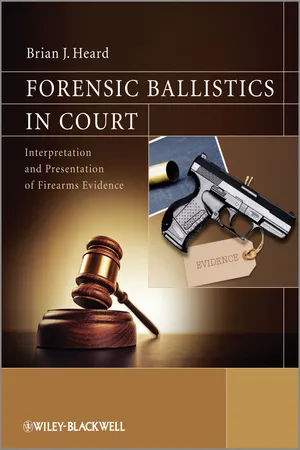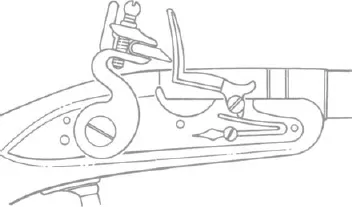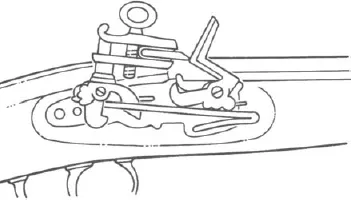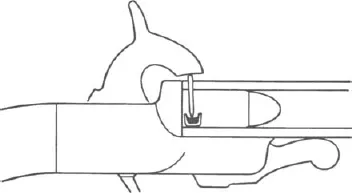
Forensic Ballistics in Court
Interpretation and Presentation of Firearms Evidence
- English
- ePUB (mobile friendly)
- Available on iOS & Android
About this book
Forensic Ballistics in Court: Interpretation and Presentation of Firearms Evidence is an accessible introduction to firearms and ballistics evidence and how this is analysed and presented as evidence in a court of law.
The book approaches the subject in terms of the realities of case work, opening with a clear and illustrated explanation of the correct nomenclature for various weapon types and their parts. Ammunition is also extensively covered, again with annotated illustrations. Basic external and terminal ballistics, wounding capabilities are likewise covered to give an overview of the subject. A key aspect of the book covers the theory and philosophy behind striation matches and the associated statistics, how positive matches should be peer reviewed and the importance accreditation has on this subject.
Gunshot residue formation and identification and the various methods used in its analysis are reviewed in depth. This includes a critical examination of the pros and cons of each type of examination and the evidential weight which can be applied to each method.
- Accessible and reader-friendly introduction to firearms and ballistics.
- Clarifies the limitations of firearms evidence.
- Extensive use of global case-studies throughout.
- Focus on the interpretation and assessment of the weight of firearms/ballistics evidence presented at court.
- Covers the importance of witness and accused statements and their interpretation in relation to the investigation under review.
- Includes coverage of gunshot residue collection, examination and interpretation and the potential for contamination of GSR samples.
- Includes numerous real life case studies that the author has dealt with over the past 45 years.
- Takes an applied approach to the subject.
Frequently asked questions
- Essential is ideal for learners and professionals who enjoy exploring a wide range of subjects. Access the Essential Library with 800,000+ trusted titles and best-sellers across business, personal growth, and the humanities. Includes unlimited reading time and Standard Read Aloud voice.
- Complete: Perfect for advanced learners and researchers needing full, unrestricted access. Unlock 1.4M+ books across hundreds of subjects, including academic and specialized titles. The Complete Plan also includes advanced features like Premium Read Aloud and Research Assistant.
Please note we cannot support devices running on iOS 13 and Android 7 or earlier. Learn more about using the app.
Information
1.0.1 Introduction
1.0.2 The Flintlock (Figure 1.0.1)

Snaphaunce (Figure 1.0.2)

Miquelet (Figure 1.0.3)

True Flintlock (Figure 1.0.4)

1.0.3 The Percussion System (Figure 1.0.5)

1.0.4 The Pinfire System (Figure 1.0.6)

Table of contents
- Cover
- Title Page
- Copyright
- About the Author
- Introduction
- About the Companion Website
- chapter 1: Firearms History
- Chapter 2: Weapon Types and Their Operation
- Chapter 3: Proof Marks
- Chapter 4: A Brief History of Ammunition
- Chapter 5: An Introduction to Ballistics
- Chapter 6: A Brief History of Forensic Firearms Identification
- Chapter 7: Basic Concepts of Striation Matching
- Chapter 8: Accidental Discharge
- Chapter 9: Identification of Calibre from the Bullet Entry Hole
- Chapter 10: Ricochet Analysis
- Chapter 11: Bullet Penetration and Trajectory through Glass
- Chapter 12: Range of Firing Estimations and Bullet Hole Examinations
- Chapter 13: The Use of X-ray Photography for Projectile Identification
- Chapter 14: Gunshot Residue Examination
- Chapter 15: Gun Handling Tests
- Chapter 16: Laser-etched Serial Numbers and Bar Codes
- Chapter 17: Classification of Firearms-related Death
- chapter 18: Practical Considerations in a Firearms Case from a Legal Point of View
- chapter 19: Qualifying the Expert and Cross-examination Questions
- chapter 20: Chain of Custody
- Appendix 1: Standard of Review: ‘Daubert Trilogy’
- Appendix 2: Commercial and General Abbreviations for Bullet Configurations
- Appendix 3: Some of the More Common Trade Names
- Appendix 4: Important Dates in the History of Firearms from 1247
- Appendix 5: Dates for the Introduction of Various Cartridges by Calibre
- Appendix 6: Some Trademarks Found on Guns
- Appendix 7: General Firearms Values Conversion Table
- Appendix 8: Hearing Loss
- Appendix 9: A List of Handgun Cartridges
- Appendix 10: A List of Rifle Cartridges
- Appendix 11: Air Weapon Legislation
- Index